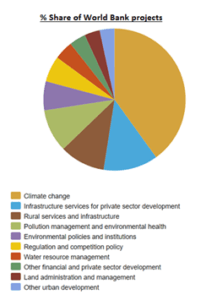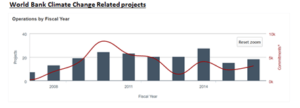The World Bank: Climate Change’s Unexpected Rival

As the issues of poverty and climate change have become more urgent, the connection between the two has become more clear to the World Bank
In December 2015, 195 countries reached a historic agreement at the UN Climate Change Conference to fight climate change—highlighted by the fact that it took place in the hottest year on record in the world (2). Recognizing the urgency of building measures against impending climate shocks, a short time later in April 2016, the World Bank released its Climate Change Action Plan (5). You might ask, what does a bank have to do with climate change? Well, the World Bank is not your typical bank in the usual sense. It was established in 1944 with the mission of “working for a world free of poverty.” Over the past 72 years, the World Bank has grown and evolved in pursuit of this mission (1). As the issues of poverty and climate change have become more urgent, the connection between the two has become more clear to the World Bank. Ultimately, the World Bank has decided that both issues can be resolved if pursued in tandem.
By producing the Climate Change Action plan, the World Bank has completed extensive planning around helping developing countries tackle climate change. In the past, the World Bank has attacked poverty by allocating its budget according to specific categories. The focus was on large infrastructure projects at first then more recently social development, including education, health, and nutrition (3). By 2009, the World Bank began devoting an increased share of resources to climate change related projects (See Exhibit 1a and 1b). As the vulnerability of poor countries faced with climate change has become more apparent, the World Bank has reset its course. It will be pursuing climate control through an integrated approach that includes “climate-smart agriculture investments like climate resilient seeds, high-efficiency irrigation, livestock productivity and early warning systems for natural disasters (5). These developing countries will need to leverage their limited resources to meet rapidly changing circumstances. Integrated spending will encourage countries to align their efforts across both and take advantage of the efficiencies between them.
The bank has also begun to deliver on its action plan. For example, it delivered $5 million in aid to Haiti, which has been designated by Maplecroft, a risk management company, the country most at risk due to climate change. Haiti’s vulnerability to extreme weather events is intensified by its high levels of poverty, environmental degradation, a poor economy, limited government and crumbling infrastructure (7). Approximately 96% of the country is exposed to two or more hazards including hurricanes, floods, earthquakes, landslides, and droughts. Most rural household incomes depend on the agricultural sector, accounting for 25% of Haiti’s GDP(8). Similarly, the action plan for other developing areas of the world like the Middle East and North Africa which is vulnerable to water availability, rising sea levels and heat waves (4). “Countries start from different points and have different emission levels and therefore need differentiated actions and support (10).”
The World Bank needs to push towards being as accountable as possible to ensure that it delivers on its action plan. Climate change integrated with poverty reduction demands a long-term and comprehensive strategy (9). This creates inherent tension against the short-term and immediate needs of a poor population. Structure and standardized metrics will need to be put in place to track results. The World Bank already keeps track of copious amounts of data related to its projects. Focused and consistent use of this data to first set up benchmarks and then determent relevant parameters will enable the World Bank to adjust as necessary in these sensitive countries. Historically, the World Bank has encountered criticism regarding its efficacy, however, now more than ever the bank can play an important role in driving preparedness across the world. Millions of people will be facing extreme weather patterns such as heat waves, droughts, floods, and hurricanes which will affect agriculture, food and water (4). In the next 15 years, the increased frequency of natural disasters will potentially push 100 million more people into poverty (5). (658 words)
Exhibit 1a
Exhibit 1b

Works Cited
[1] “Climate Change Overview.” Climate Change Overview. N.p., n.d. Web. 04 Nov. 2016.
[2] “COP21: We Have a Paris Climate Agreement. Now What?” CNN. Cable News Network, n.d. Web. 04 Nov. 2016.
[3]”Global Climate Change Alliance+.” Support for Climate Change Integration in Haiti’s National Development. N.p., n.d. Web. 04 Nov. 2016.
[4] “Haiti to Better Prepare for Weather and Climate Shocks.” World Bank. N.p., n.d. Web. 04 Nov. 2016.
[5] “History.” History. N.p., n.d. Web. 04 Nov. 2016.
[6] Mindock, Clark. “Haiti Hurricane Matthew Climate Change Effects: Global Warming Means More Devastation, Climate Refugees.” International Business Times. N.p., 05 Oct. 2016. Web. 04 Nov. 2016.
[7] “World Bank Group Climate Change Action Plan.” (2016): n. pag. 7 Apr. 2016. Web. 4 Dec. 2016.
[8] “World Bank Group Sets New Course to Help Countries Meet Urgent Climate Challenges.” World Bank. N.p., n.d. Web. 04 Nov. 2016.
[9] “World Bank Group Unveils New Climate Action Plan.” World Bank. N.p., n.d. Web. 04 Nov. 2016.
[10] “World Bank Group (WB).” World Bank Group (WB). N.p., n.d. Web. 04 Nov. 2016.




It is very interesting to learn that the World Bank is shifting part of his focus towards project with high sustainability objectives and I do hope that this is trend we will increasingly see moving forward in the project funded by multi-national or bilateral agencies. However, having studied different projects led by the World Bank, one of the biggest issue they usually face is to find the right expertise and skills among local resources to efficiently implement those projects. How should they tackle the issue of sourcing this specific expertise?
Very interesting piece. I think the decision of whether to integrate climate change funding with existing, more established sectors (health, infrastructure etc.) or to treat climate change as a separate sector in its own right is an interesting one. I think that the success of this decision will largely depend on what happens external to the Bank – it will come down to whether service providers and delivery partners (who the Bank fund to implement projects) see integration with other sectors in the same way and if they are successful at doing so. What incentives does, for example, an NGO focused on healthcare have to go after climate change funding and develop integrated programmes? Even if it’s incentivised, does it have the capacity and expertise to do so?
Thanks for sharing. It strikes me that fighting climate change and poverty may actually be at odds much of the time. As more and more people come out of poverty, energy consumption and greenhouse gas emissions will no doubt increase. That being said, I think we all agree the mission to erase poverty is of the utmost importance. I wonder how the World Bank thinks about this tension and investing behind it?
It’s great to know that World Bank is changing its approach from being reactive to more integrated solution that addresses root causes of global warming. My question is how World Bank effectively collaborates with private entities and local government to deliver results sustainably. Given that the incentive structure of private sector contract usually provides more powerful motivation to stakeholders to drive changes, World Bank will need to think about methods to get more involvement from various key stakeholders.
Thanks for sharing this interesting article with us!
Interesting perspective Van. I’m always concerned about how these quasi-governmental institutions that work in “third-world” countries engage the public and private sector organizations within said country, specifically when the quasi-governmental institution is providing aid. Particularly, I want to ensure that organizations like the World Bank are enabling communities to find solutions to their own problems and partnering with them in ways that enhances the knowledge of the local institutions. In this case, I think the World Banks’s cause is noble. I’d like to see how their efforts in Haiti develop
Thanks for this thoughtful and illuminating post. It inspired me to read the Shock Waves report by The World Bank on how climate change can prevent mobility out of poverty (https://openknowledge.worldbank.org/bitstream/handle/10986/22787/9781464806735.pdf). The report highlighted to me the role of climate change in food insecurity. I am curious as to whether there is an opportunity for industry-representing organizations to lobby for international policy changes that ensure responsible consumption as it relates to climate change’s effect on food security. It seems to me that there is a bit of a collective action issue. Unless both government and industry agents can come together to commit to group action, there will be natural distributive effects that favor those who continue to produce seeds that cannot be consumed responsibly.
Very interesting post! Thank you! It seems to me from what I am reading that World Bank is actually quite inefficient. It didn’t manage to help “New Kyoto” protocol to get signed by crucial countries and ad hoc support for post-disaster relief for Haiti is a post factum action that is not addressing the core of the problem. New plans are being created at HQ of WB but little execution is done. Even in the space of spreading the consciousness about the problem among countries, decision makers and citizens the WB is not truly visible. I dare to say Leonardo di Caprio is doing more for Climate Change problem widespreading than WB. Hope the competition from the newly established Asian Infrastructure Investment Bank will lead to increase of effectiveness of WB.
Really good post. I think it’s imperative that international and influential organizations such as the World Bank focus more on climate change since it’s these same organizations that have the most power to actually implement change in the world. My only concern regarding this approach is that the bank is investing in particular projects around the developing world instead of making green energy more affordable for those countries that have been struck the most by climate change.